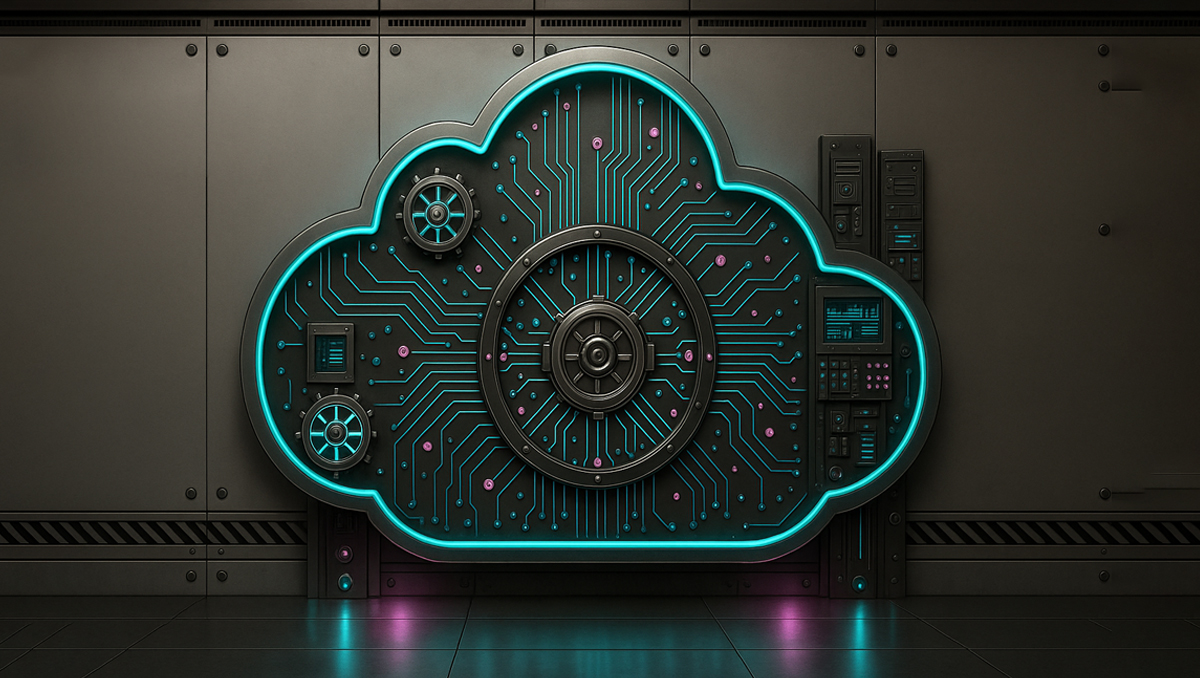TL;DR
- Enterprise cloud security is fragile because even one mistake, like a public storage bucket, an over-permissive IAM role, or an exposed API, can expose millions of records. Zapier’s 2025 breach from a misconfigured MFA flow is a clear example.
- The main risks to cloud security for enterprise environments are insecure Kubernetes defaults, unauthenticated APIs, stolen or long-lived credentials, plaintext secrets in IaC state files, missing audit logs, unsafe root account use, and rushed emergency fixes that leave systems wide open.
- Manual checks don’t scale in enterprise-managed cloud security. With thousands of buckets, clusters, and serverless functions across AWS, GCP, and Azure, teams struggle with a lack of visibility, shadow IT, dynamic workloads, and fragmented compliance frameworks.
- To enforce enterprise cloud security and governance, controls must be automated. This includes running policies in CI/CD, ensuring IAM roles are least-privileged with hardware MFA, requiring CMEK and TLS for data, authenticating APIs and rate-limiting them, and automatically detecting and remediating drift.
- Firefly applies rego policies consistently across clouds and IaC, blocking misconfigurations before deployment, maintaining continuous compliance records, supporting custom rules, and enforcing guardrails that scale with enterprise workloads.
Enterprises now run their most critical systems in the cloud, from AWS Redshift data lakes, to GCP GKE clusters powering AI workloads, to financial applications on Azure SQL. With that scale, even small errors have a significant impact.
The numbers underscore the fragility of the environment. Tenable’s 2025 report found that 9% of publicly accessible storage buckets hold sensitive data, with most of it classified as restricted. More than half of AWS ECS and GCP Cloud Run task definitions embed secrets directly in configs, and 29% of organizations still run workloads that are simultaneously public, vulnerable, and over-privileged. High-profile incidents, such as Microsoft’s 38TB exposure through a misconfigured Azure storage bucket, demonstrate how a single slip can compromise petabytes of enterprise data.
The rest of this blog delves into these recurring weaknesses in enterprise cloud environments, illustrates how they manifest in real-world incidents, and demonstrates how Firefly enforces guardrails with policy-as-code to maintain consistent, compliant, and secure environments across AWS, Azure, and GCP.
Key Security Threats to Enterprise Cloud Environments
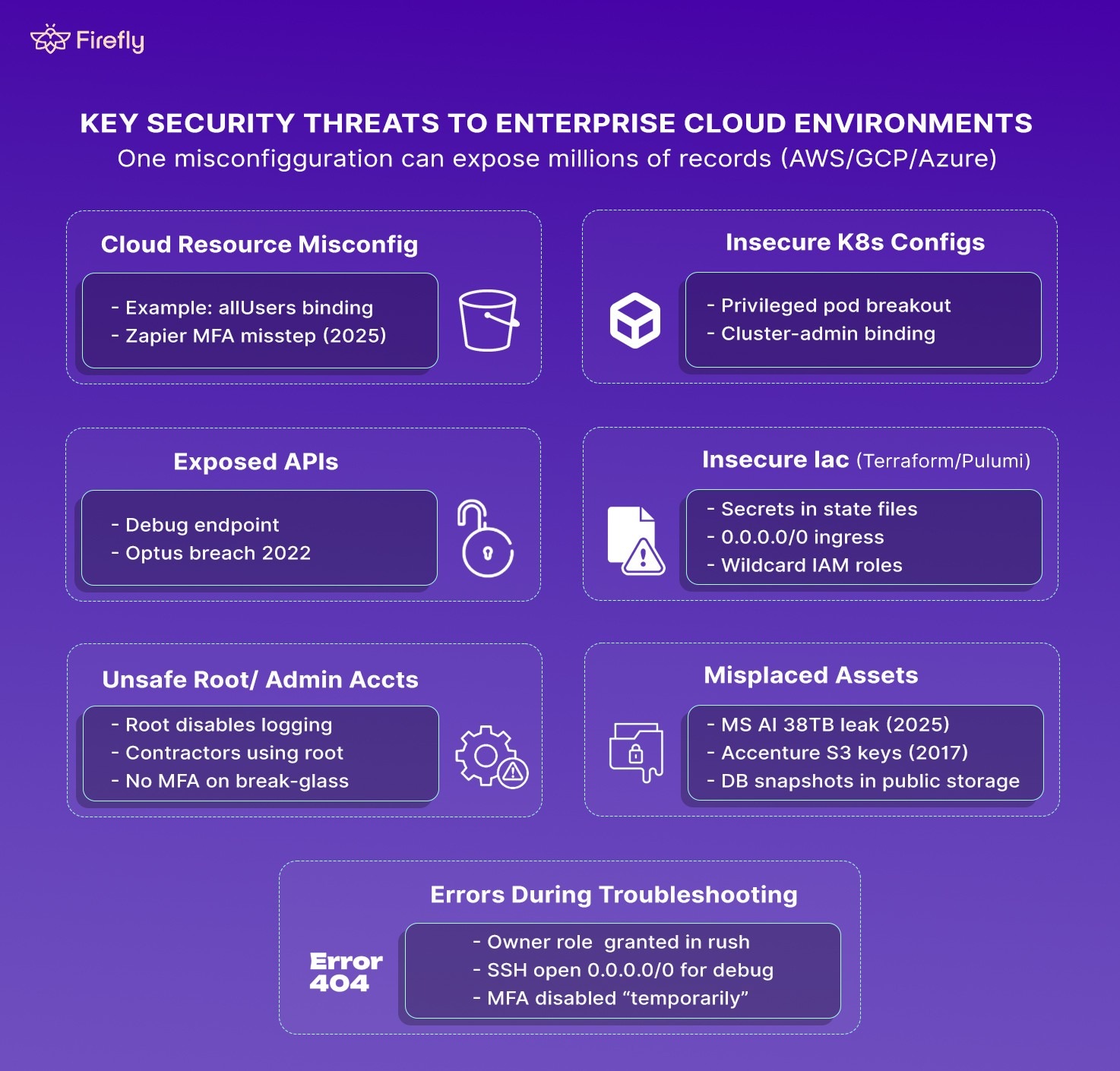
Enterprise cloud isn’t just “a few VMs.” It’s sprawling, hundreds of buckets across regions, multiple Kubernetes clusters with dozens of namespaces, thousands of ephemeral serverless functions, and separate identity providers all federated into the same accounts. With that kind of surface area, small missteps have a massive blast radius. Below are the issues discussed briefly that frequently appear in recent breaches and post-mortems.
1. Cloud Resource Misconfigurations
Still the number one source of leaks. Even one permissive IAM binding or public bucket is enough. In February 2025, Zapier confirmed that attackers bypassed misconfigured MFA to access internal repos, not a zero-day, just a routine identity misstep.
A Terraform example makes the risk obvious:
resource "google_storage_bucket" "public_bucket" {
name = "company-backups-public"
location = "US"
uniform_bucket_level_access = true
}
resource "google_storage_bucket_iam_member" "pub_read" {
bucket = google_storage_bucket.public_bucket.name
role = "roles/storage.objectViewer"
member = "allUsers" # <-- world-readable
}If logs or backups land here, they’re instantly exposed. The fix is to block allUsers and allAuthenticatedUsers at the org level, enforce least privilege in IAM, and fail builds that violate these policies.
2. Insecure Kubernetes Configurations
Kubernetes is often where attackers move laterally once they’re in. One common mistake is deploying privileged pods with host-level access. For example:
apiVersion: v1
kind: Pod
metadata:
name: bad-priv-pod
namespace: default
spec:
hostPID: true
hostNetwork: true
automountServiceAccountToken: true
containers:
- name: toolbox
image: alpine:3.20
securityContext:
privileged: true
runAsUser: 0
allowPrivilegeEscalation: true
volumeMounts:
- name: dockersock
mountPath: /var/run/docker.sock
command: ["sh","-c","sleep 360000"]
volumes:
- name: dockersock
hostPath:
path: /var/run/docker.sock
type: Socket
What looks like a harmless debug pod is effectively root on the node: privileged: true strips container isolation, hostPID/hostNetwork expose host processes and NICs, and the Docker socket mount allows full control of the runtime. If an attacker compromises this pod, they can escalate to the host and spread across the cluster.
RBAC misconfigurations are just as bad. A binding like this:
apiVersion: rbac.authorization.k8s.io/v1
kind: ClusterRoleBinding
metadata:
name: everyone-is-admin
roleRef:
apiGroup: rbac.authorization.k8s.io
kind: ClusterRole
name: cluster-admin
subjects:
- kind: ServiceAccount
name: default
namespace: defaultmeans every pod running with the default ServiceAccount (which is most pods unless overridden) has full cluster-admin rights. That turns even a minor web app exploit into a total cluster takeover. The fixes are clear: admission controls (PSA, Kyverno, Gatekeeper) to block privileged pods and dangerous bindings, and regular RBAC audits to catch these mistakes before attackers do.
3. Unauthenticated or Exposed APIs
Debug routes are often left in production by mistake, and they quickly turn into infrastructure entry points. Modern workloads on AWS ECS, GCP Cloud Run, or Kubernetes automatically inject environment variables into containers for cloud credentials, database URLs, and service tokens. A debug route that dumps those variables hands attackers direct access to the infrastructure.
Example in Node.js:
// Debug route accidentally left in production
app.get("/internal/debug", (req, res) => {
res.json({ env: process.env });
});What leaks through process.env:
- AWS ECS / Lambda → AWS_ACCESS_KEY_ID, AWS_SECRET_ACCESS_KEY from IAM roles.
- GCP Cloud Run / GKE → service account tokens and project-wide credentials.
- Kubernetes → mounted secrets like DB_PASSWORD or API keys.
With those values, attackers can list and download S3 buckets, spin up new compute, or dump production databases. It’s no longer “just an app bug”, it’s a full infrastructure compromise.
These routes also create application-layer risks: they can be hit with automated scans or DDoS-style probing, generating unnecessary load on the service. For a real customer, that means degraded performance, noisy error responses, or even downtime — long before an attacker escalates into infra.
Fixes:
- Enforce authentication and rate limits at the ingress or API gateway level.
- Strip debug endpoints from production builds in CI/CD.
- Rotate any secrets exposed, and prefer short-lived tokens (STS, Workload Identity).
- Add policy-as-code guardrails to block unauthenticated endpoints from being deployed.
4. Insecure Infrastructure-as-Code (IaC)
Terraform and Pulumi make provisioning repeatable, but they also make mistakes repeatable at scale. The same issues crop up again and again in real incidents:
- Sensitive Data in State Files – plaintext DB passwords, tokens, and keys committed to GitHub or stored in S3/GCS buckets without encryption.
- Overly Broad Network Rules – 0.0.0.0/0 ingress left in shared modules; dev configs leaking into prod.
- IAM Role Misconfigurations – wildcards like * or high-level roles (AWS iam:PassRole without conditions, GCP service accounts with roles/owner, Azure subscription-wide Contributor).
- Hardcoded Cloud Credentials – inline access keys in Terraform providers or Pulumi code checked into Git history.
- Unrestricted Public Endpoints – buckets created with public-read, or Pulumi exports logging sensitive data.
A typical unsafe backend config looks like this:
terraform {
backend "s3" {
bucket = "myteam-tfstate"
key = "prod/terraform.tfstate"
region = "us-east-1"
# No encryption, no bucket policy, risk of public ACL
}
}If that bucket is ever misconfigured, attackers gain access to the entire environment map, including credentials. The fix is policy-as-code: encrypted remote backends, secret scanning, org-wide blocks on 0.0.0.0/0, and OPA/Conftest checks that fail unsafe changes before they reach prod.
5. Unsafe Use of Root or Admin Accounts
Every cloud has “break-glass” accounts, AWS root, Azure global admin, GCP org admin. Using them for daily ops is reckless. Incident responders keep seeing contractors logging in with AWS root, MFA disabled “temporarily,” and never turned back on. Attackers who get hold of these accounts can disable audit logging, rotate creds, and persist quietly. Reserve them for emergencies, enforce hardware MFA, and funnel all daily work through scoped roles or federated IdPs.
6. Data Exposure Through Misplaced Assets
Not all leaks are hacks; sometimes, data is simply left exposed. Microsoft’s AI team accidentally exposed 38TB of internal data in 2025 via a misconfigured bucket. Accenture left client keys in open S3 buckets in 2017. More recently, internal database snapshots and nightly backups have been increasingly appearing in public storage. These issues can be prevented with organization-wide public access blocks, DLP scanning in CI/CD, and continuous audits for exposed assets.
7. Errors During Troubleshooting
At 3 a.m., when a job is failing, engineers often take shortcuts:
- Giving Owner role to a user to “just make it work.”
- Opening SSH (0.0.0.0/0) for quick access.
- Disabling MFA for a contractor account.
These fixes often never get rolled back. What started as a temporary patch becomes a standing vulnerability.
In practice, cloud breaches aren’t about rare zero-day exploits. They arise from predictable missteps: public buckets, exposed APIs, weak IAM policies, and forgotten debug configurations. At enterprise scale, these issues multiply, and the only realistic defense is continuous, automated policy enforcement to prevent unsafe settings from persisting.
Where Cloud Security Fails at Scale
The hardest part of cloud security isn’t writing the first IAM policy or turning on encryption; it’s maintaining consistency once the setup expands into a full-fledged enterprise footprint.
A typical mid-to-large company looks like this:
- GCP runs AI/ML pipelines on GKE, storing logs and training data in buckets.
- AWS powers analytics with Redshift and a large S3 data lake.
- Azure hosts finance on Azure Functions and SQL Database.
On top of this, you’ve got CI/CD pipelines deploying daily, multiple teams spinning up resources in their own projects, and compliance requirements that don’t stop. That’s the environment: thousands of moving parts across three providers, all evolving at the same time.
1. Multitenant Cloud Environments
Cloud is inherently shared. Misconfigured IAM or network access erodes isolation:
- AWS IAM role with sts:AssumeRole open to “*”.
- GCP VPC peering rule that unintentionally allows unrestricted traffic between projects.
- Azure Contributor role granted at subscription scope.
One incorrect configuration, and workloads that should never communicate can suddenly do so.
2. Lack of Visibility
Each provider exposes resources differently. There’s no single command to say: “Show me every bucket across AWS, GCP, and Azure that’s exposed to the internet.” Even within GCP, the check is tedious:
gcloud storage buckets list --format="value(name)"
gcloud storage buckets get-iam-policy BUCKET_NAME
# Look for "allUsers" or "allAuthenticatedUsers"Multiply that by hundreds of projects and thousands of buckets, and manual review quickly becomes impossible.
3. Dynamic Workloads
Containers and serverless workloads live for minutes, not months. A misconfigured pod might run for 60 seconds, long enough to mount an IAM token or secret that persists far longer. By the time security teams look, the pod is gone, but the compromise remains.
4. Regulatory Compliance
Frameworks like PCI-DSS, HIPAA, and GDPR require proof of encryption, least privilege, and no public access. AWS Config rules don’t map directly to GCP or Azure, so the same control has to be written three times. Enforcing consistency across clouds is brittle and error-prone.
Why Manual Enforcement Breaks, and How to Catch Issues Early
The challenges listed above frequently appear in our daily deployments when inspecting actual IaC. Take a Terraform plan for a Google Cloud Storage bucket. The intent here is to create a “secure” logging bucket:
❯ terraform plan -var-file="dev.tfvars" -out="plan.new.tfplan"
...
# google_storage_bucket.secure_bucket will be created
+ resource "google_storage_bucket" "secure_bucket" {
+ name = "instance-logs-4"
+ location = "US-CENTRAL1"
+ uniform_bucket_level_access = false #UBLE disabled
+ public_access_prevention = (known after apply)
+ versioning { enabled = true }
+ encryption {
+ default_kms_key_name = (known after apply)
}
}
# google_storage_bucket_iam_member.sa_object_view will be created
+ resource "google_storage_bucket_iam_member" "sa_object_view" {
+ bucket = "instance-logs-4"
+ role = "roles/editor" # overly broad IAM role
+ member = "serviceAccount:bucket-reader@..."
}
Plan: 6 to add, 0 to change, 0 to destroy.
At first glance, this looks fine: a bucket with encryption and versioning. But hidden in the details are violations tied to the exact challenges above:
- Visibility problem: uniform_bucket_level_access = false isn’t obvious without digging into the plan.
- Shadow IT risk: someone could merge this plan without realizing it violates baseline policies.
- Compliance gap: roles/editor on a bucket is far beyond least privilege and would fail PCI-DSS.
Now run Conftest against the plan:
terraform show -json "plan.new.tfplan" > plan.json
conftest test plan.json --policy ../policy
Output:
FAIL - plan.json - main - IAM member uses broad role "roles/editor" for principal "serviceAccount:bucket-reader@..."
1 test, 0 passed, 1 failureOPA policies flag the broad role immediately. Similar policies block public access (allUsers), enforce UBLE, and require CMEK.
What This Plan Reveals About Cloud Security Gaps
- Multitenancy: a broad IAM role (roles/editor) is exactly how access bleeds across projects.
- Visibility: manual inspection would miss this unless someone read every line of every plan.
- Shadow IT: A developer could apply this directly in rush hours, introducing a non-compliant bucket.
- Dynamic workloads: By the time anyone inspects live buckets, it may already have been used to exfiltrate data.
- Compliance: this single misstep fails least-privilege controls across PCI-DSS, HIPAA, and GDPR.
The example above illustrates why manual reviews fail to scale and why policy-as-code becomes important. Security has to shift left into the pipeline, catching violations before they ever reach the cloud.
Building Scalable Guardrails for Enterprise Cloud Security
The only way to deal with the complexity of modern cloud environments is to stop relying on manual reviews and shift security into the workflow itself. Guardrails need to be codified, enforced continuously, and remediated automatically. The core practices look like this:
Policy Enforcement and Compliance Automation
Policies should run every time infrastructure changes. Instead of spot-checking live environments, integrate tools like OPA/Conftest or cloud-native policy engines (AWS Config, GCP Organization Policy, Azure Policy) directly into CI/CD. This way:
- A Terraform plan that tries to assign roles/editor to a service account fails the pipeline.
- A bucket missing CMEK or UBLE never gets deployed.
- Policies run on every change, not once a quarter.
Identity and Access Management (IAM) Hygiene
Enforce least privilege and watch for sprawl:
- Replace broad roles (roles/editor, roles/owner) with scoped roles or custom roles.
- Require hardware-backed MFA (FIDO2 keys) for console logins.
- Monitor for new service account keys; those should be rare. Prefer short-lived tokens like Workload Identity in GCP or IAM Roles for Service Accounts in AWS.
- Run scheduled checks for dormant users and unused permissions.
Encryption and Data Protection
Every storage system must default to encryption in transit and at rest. Go further with Customer-Managed Encryption Keys (CMEK):
- Create a dedicated KMS key ring for security-sensitive buckets.
- Enforce CMEK at the bucket or dataset level via policy.
- Rotate keys regularly (every 30 days), and audit KMS logs to identify who accessed them.
API Security
APIs are often the thinnest exposed surface:
- Require authentication and authorization on every endpoint, even internal ones.
- Put API gateways or load balancers in front of services to apply rate limits and quotas.
- Strip out debug endpoints before deploying; these are common sources of leaks.
Automated Remediation and Monitoring
Detecting misconfigurations is only half the battle. Fixing them at scale is where automation matters:
- Drift detection: alert when live state diverges from IaC.
- Automated pull requests: when a bucket goes public, trigger a bot that raises a PR to fix the Terraform.
- Runtime remediation: if a security group suddenly allows 0.0.0.0/0 on port 22, automation should close it immediately and notify the team.
Think back to the Terraform plan with the roles/editor binding. Manual checks wouldn’t have caught it in time, but a Conftest policy blocked the deployment before it applied. That’s the model to scale: every change runs through automated checks, with violations surfaced as failed tests, not incident reports.
This shifts cloud security from reactive firefighting into proactive guardrails, catching issues before they ever reach production.
How Firefly Addresses Cloud Security Challenges
What usually slows teams down isn’t the lack of security tools; it’s the constant rework to enforce the same controls differently in AWS, GCP, and Azure. One cloud refers to it as IAM roles, another uses IAM bindings, and the third uses RBAC. Storage services each have their own defaults for encryption and public access. Without a unifying layer, every policy becomes three separate scripts and a lot of human review.
Firefly removes that friction. It provides a single governance engine, powered by rego, that applies policies consistently across clouds and IaC. Instead of maintaining custom scripts per provider, you define a rule once, for example, “all buckets must have CMEK and block public access”, and Firefly enforces it everywhere, from Terraform plans in CI to live cloud resources.
Security as Code with OPA
The risks outlined earlier, from GCS buckets with allUsers access, to Kubernetes pods mounting /var/run/docker.sock, to Terraform state files leaking secrets, are all config errors that slip past manual checks. Firefly tackles them by treating security policies as code, versioned and tested just like your applications.
- A single OPA rule can block roles/storage.objectViewer bindings in GCP, public-read ACLs in AWS S3, and overly broad Contributor roles in Azure.
- Another policy can reject Kubernetes manifests with privileged: true or /var/run/docker.sock mounts before they ever hit the cluster.
- Terraform and Pulumi plans are evaluated at commit time, catching hardcoded credentials, wildcard IAM roles, or unencrypted storage before they reach production.
Firefly ships with prebuilt policy packs aligned to CIS, PCI-DSS, HIPAA, and GDPR, but it also lets you extend with custom OPA rules tailored to your environment. For example:
- Require all ML inference endpoints to sit behind an API gateway.
- Block deployments in unapproved cloud regions.
- Enforce CMEK across all sensitive data stores.
Because Firefly evaluates both IaC plans and live resources, it closes the gap between what’s in code and what’s actually deployed. The diagram illustrates how Firefly integrates with developer IDEs, IaC repos, CI/CD pipelines, and cloud provider APIs. Policies are evaluated before deployment and at runtime, with violations surfaced through notifications and automated fixes:
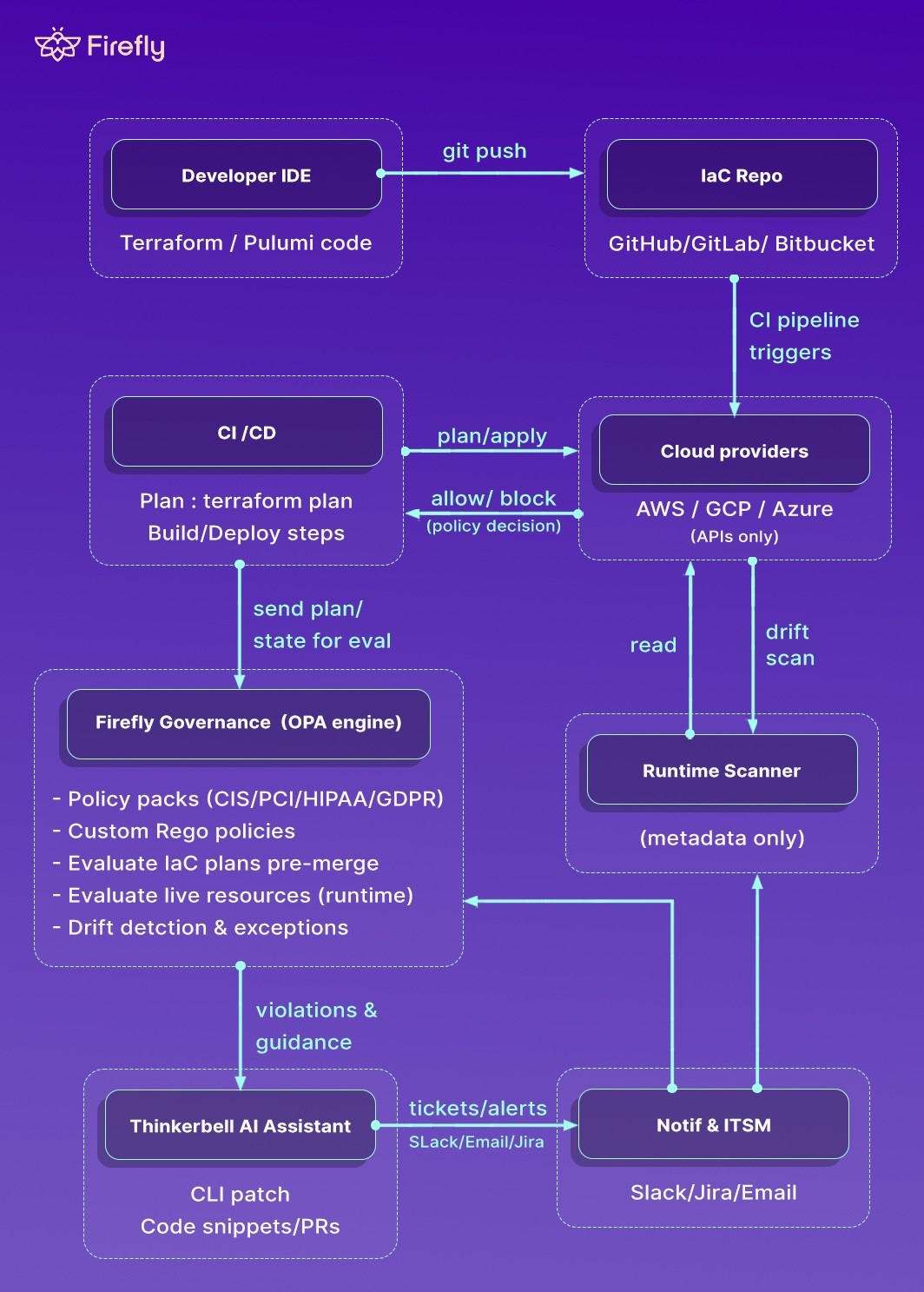
The visual above shows that Firefly eliminates the “visibility” problem: you’re no longer grepping through terraform plan output or juggling aws and gcloud CLI scripts for multiple accounts with different CSPs. Instead, you get one continuous enforcement layer, running across every cloud and pipeline.
In the screenshot below, Firefly flags network and firewall misconfigurations across AWS, Azure, and GCP, things like unrestricted SSH/RDP, default VPC usage, and exposed ports:

These are the same “shadow IT” and “visibility” issues that typically require custom scripts per cloud.
Continuous Compliance and Auditability
Firefly is SOC 2 Type II certified and aligns with ISO 27001, GDPR, and HIPAA frameworks. Beyond its own certifications, it helps you keep your workloads compliant:
- Every violation is logged with an audit trail, including who created it, when, and which policy it violated.
- Dashboards surface compliance scores across frameworks, with drill-down by team or environment.
- For vendor reviews, you can request Firefly’s SOC 2 report or refer to their Trust Center, which documents certifications and third-party audits.
This directly addresses the compliance drift problem: instead of manually proving encryption or least-privilege every quarter, Firefly maintains a continuous record of whether you’re in or out of compliance. In the encryption-focused view below, Firefly highlights issues like unencrypted DOCDB clusters, Athena DBs without CMKs, and TLS not enforced on storage accounts:
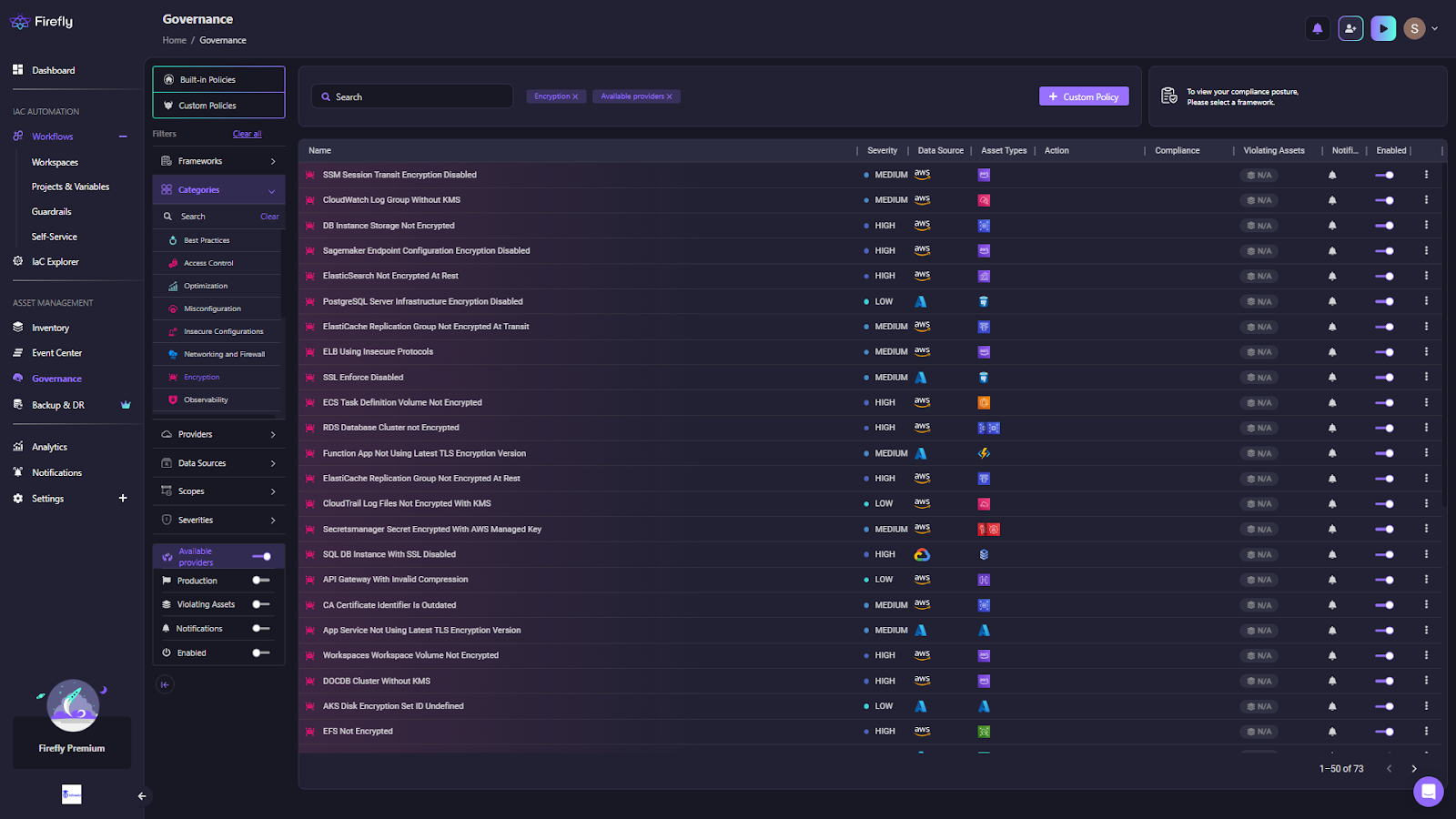
Instead of quarterly audits surfacing these gaps, you see them live in a single place.
Secure by Design Architecture
Firefly doesn’t pull in workload data. It only scans metadata and configs via provider APIs and state files. A few important details engineers usually ask about:
- Encryption: TLS for data in transit, AES-256 for data at rest, with keys managed via Vault.
- Isolation: strict tenant boundaries, strong IAM at every layer, scoped access tokens.
- Privacy: no customer data (like S3 object contents) is ever ingested; only resource metadata is.
- Network control: if you operate strict firewalls, you can whitelist Firefly’s scanning IPs or domains.
For an enterprise, this matters because you’re not adding another blind spot. Firefly is designed to operate with the least access, which means it’s usable even in regulated environments.
Centralized Visibility
Finally, Firefly pulls assets from AWS, GCP, Azure, and SaaS into a single inventory:

From there, you get:
- Compliance scores by framework (PCI-DSS, HIPAA, GDPR).
- Policy violations grouped by project/team.
- Historical trends show whether posture is improving or degrading.
Compare that to the manual process of exporting IAM policies from each provider, it’s the difference between having real-time visibility and waiting for a red-team report..
Writing Custom Policies in Firefly
Built-in policies cover most baselines, but every enterprise has org-specific rules: maybe all buckets must log to a central audit project, or no VM should have a public IP. Firefly supports both no-code policy building and policy-as-code in Rego.
1. Choose Your Policy Type
From the Create Custom Policy view, you can either use the No-Code Policy Builder for common patterns or go deeper with Rego for fine-grained rules.

2. Writing a Rego Rule
At enterprise scale, security isn’t just about catching one-off mistakes; it’s about enforcing thousands of rules across AWS, Azure, and GCP without drowning in manual policy writing. Rego, while powerful, can become unmanageable when every team has to reinvent the same checks for buckets, VMs, and IAM roles in their own codebases.
Firefly reduces that burden by giving enterprises a built-in Rego playground. Teams can start with baseline policies (e.g., PCI-DSS, HIPAA, CIS) and extend them only where necessary. For example, the following rule blocks Google Compute Engine (GCE) VMs from being created with a public IP:

The rule inspects network interfaces and blocks any instance with access_config defined. This rule is categorized as Critical, tied to the “Security” category, and scoped to relevant assets. Once saved, it behaves like any built-in policy: evaluated on Terraform plans and runtime resources.That takes Rego from a developer-friendly tool to something usable at enterprise scale, where consistency is often the hardest problem.
3. Adding Notifications
Once the policy is active, you can connect it to notification channels. For example, every violation of the “GCE VM Access” policy could be sent to a Slack channel or Jira queue.

This ensures issues don’t just sit in a dashboard; they’re routed directly to the teams who own the resource.
By combining built-in guardrails with custom rules, Firefly adapts to your environment. A single enforcement layer covers both baseline compliance (PCI, HIPAA, SOC 2) and your organization-specific requirements.
Automated Remediation in IaC Workspaces
The Governance view displays policies and violations across environments; however, actual blocking and remediation occur when configurations are deployed through Firefly Workspaces. Guardrails act as enforcers inside the pipeline, making sure Terraform plans that break compliance never reach production.
Here’s how it works in practice:
1. Defining Guardrails for IaC
In the Guardrails Wizard, you define rules that apply directly to workspaces. These can enforce policies like CMEK usage, block public storage access, or prevent broad IAM roles. For each rule, you can scope it to specific repos, branches, or workspaces and decide whether violations should warn or strictly block a deployment.
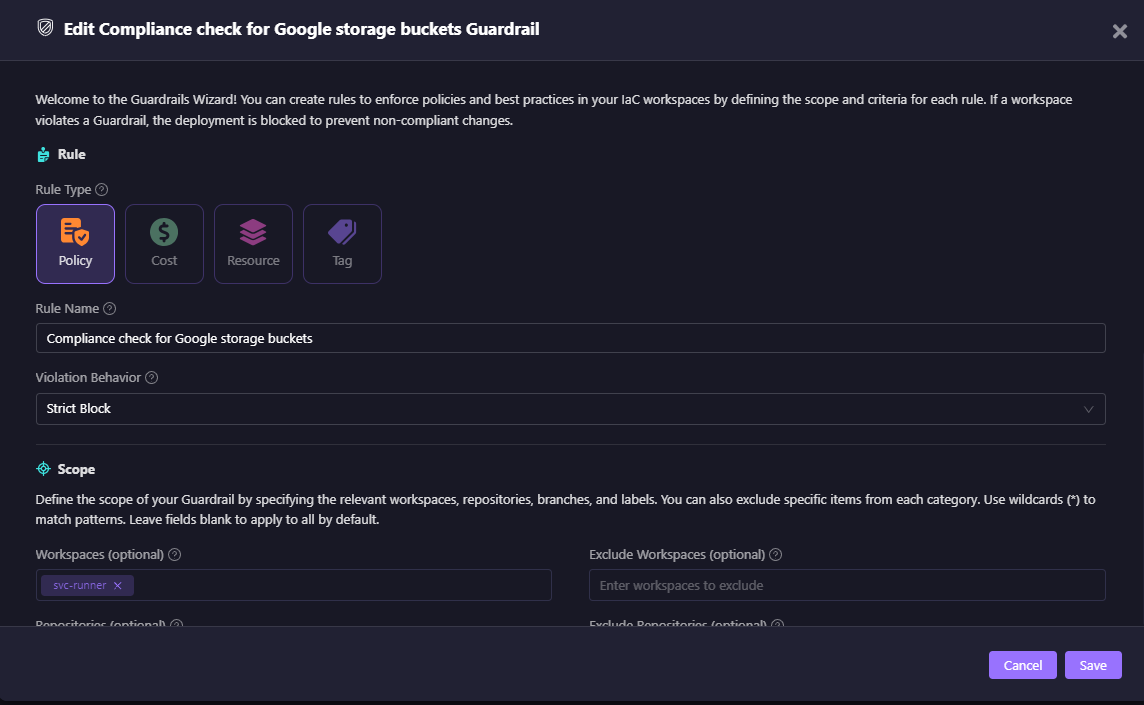
In this example, a compliance check for Google Storage buckets was created that strictly blocks any bucket missing uniform access control.
2. Enforcement During Deployment
When a developer runs a Terraform plan inside a Firefly Workspace, the Guardrails kick in automatically. If a violation is detected, the pipeline halts before applying, and the developer sees exactly why as shown in the blocked workspace below:

Here, a deployment was blocked because the GCS bucket config disabled uniform_bucket_level_access. Firefly not only flagged the violation but also surfaced the Thinkerbell AI Assistant, which recommended the exact fix and even generated the Terraform snippet to correct the code. By unifying guardrails across clouds, treating security as code, and automating both enforcement and remediation before issues arise in production, Firefly transforms cloud security from reactive firefighting into proactive control. For enterprises running at scale, this means fewer manual checks, fewer surprises in audits, and stronger confidence that every deployment meets both security and compliance standards.
FAQs
Q: Why is cloud security so hard?
Cloud adoption is usually led by DevOps, not security. By the time security teams get involved, there are already hundreds of buckets, IAM roles, and clusters deployed. Each cloud has different controls (IAM vs. RBAC), making visibility and consistent enforcement almost impossible without automation.
Q: What is managed cloud security?
It’s outsourcing cloud security operations to a vendor. They scan configs for misconfigs, monitor drift outside IaC, map controls to compliance frameworks (CIS, PCI, HIPAA), and provide 24/7 alerting/response tuned for AWS, GCP, and Azure.
Q: What is enterprise security?
Enterprise security applies consistent controls across large, distributed environments. It means enforcing MFA (ideally FIDO2), TLS, and CMEK for data, VPN/Zero Trust for remote access, and central SIEM/EDR monitoring to prevent a single weak role or exposed API from compromising the org.
Q: What are the four types of cloud security?
Cloud security is typically categorized into four key areas. Network security protects cloud traffic with firewalls, microsegmentation, and private endpoints. Identity and access management (IAM) enforces least privilege, MFA, and scoped roles to reduce account abuse. Data encryption safeguards information at rest and in transit, often with CMEK or HSM-backed keys. Compliance monitoring conducts continuous checks against frameworks such as PCI-DSS, HIPAA, and GDPR to detect drift and verify adherence.
